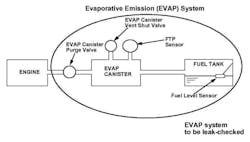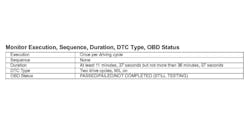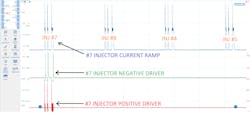Content brought to you by Motor Age. To subscribe, click here.
Welcome back to another edition of “The data doesn’t lie,” a regular feature in which I pose a puzzling case study, followed by the answers to the previous issue’s puzzle.
What You Will Learn:
• DTC set criteria save time that would be wasted on fruitless road test
• Reading service information before attempting analysis helps develop a sound diagnostic game plan
• Confirming system activity with a multi trace lab scope allows a story to be told about the functionality of the entire system being analyzed
For automotive emissions control, it truly takes a team. One of the team members is the evaporative emissions control system (EVAP). But, in the case of this 2013 Honda Crosstour, it seems this EVAP system is a huge letdown on just about every trip the vehicle makes.
Preliminary data
As the vehicle is driven and meets the criteria for an EVAP large leak test, a failure occurs, and the vehicle displays the message “Check fuel cap” on the instrument panel cluster. The strange part is the vehicle has no pending, current, or history DTCs. Even stranger, the message is displayed whether the driver made a pit stop for fuel or not. I mention that because in my experience, most vehicles will correlate a loose fuel cap with a large leak test failure that occurs only after a change in fuel level (usually a change in level of about 25 percent). And that typically sets a pending DTC. What’s more, this vehicle (like most today) implements a key-off natural vacuum testing strategy. This type of testing all but eliminates the fuel-volatility issue that can mask smaller leaks during driving conditions and with the heat of the exhaust system beneath the fuel tank. Today, systems are capable of detecting EVAP leaks as small as 0.010.”
An EVAP function test was carried out using the scan tool's bidirectional control. This allows the PCM to run the engine (vacuum source) and systematically operate the EVAP vent valve and purge valve to check the integrity of the EVAP system by placing it in a vacuum state (Figure 1). It monitors the integrity of the system from the feedback signal of the fuel tank pressure (FTP) sensor. Very little change in FTP signal occurred during the test, meaning no leak was present. As a result, the EVAP function test passed with flying colors each and every time it was conducted.
According to Mitchell 1, the criteria to be met to run the test for a large leak/loose fuel cap (P0455) are as follows (Figure 2):
- After engine shutdown, monitor for engine-off natural vacuum (EONV).
- The FTP is monitored for pressure change for at least 11 min, 37 seconds, and no more than 36 minutes, 37 seconds.
- The engine must be off for at least six hours in order to begin a new drive cycle.
- A sufficient amount of intake air temperature and coolant temperature change must occur.
- These tests occur once per drive cycle and must fail twice in a row to set a DTC.
Now, for another strange series of events. As you can see, the criteria clearly state the test is conducted with the engine off. However, the failure only occurs when driving down the highway after about 20 minutes of runtime. I advised the technician to drive the vehicle until the message appeared. I then instructed the technician to conduct the EVAP function test again. However, the results of the test still showed It passing. Again, the test passed. This data was contradictory to what the PCM sees during the self-test while driving the vehicle down the road.
The technician attempted to graph the EVAP purge solenoid duty cycle, EVAP vent solenoid, and FTP PIDs (during the 20-minute test drive when the failure occurred). However, there was no way to configure the scan tool to display all three of those PIDs simultaneously. Although it was frustrating, the technician used two different scan tools with the same results.
The data doesn’t lie
With all the information in front of us, and the desired information not yet obtained, we are faced with deciding how to proceed. Here are some bullet points of what we know to be factual, and I will ask all of you, diligent readers, for your input:
- The “check fuel cap” message appears after every drive of 20 minutes or more
- No pending, current, or history DTCs are stored, although it's been an ongoing issue for more than two years
- The EVAP system function self-test never fails
- According to service information, the PCM tests for large leaks and small leaks at key-off only
Given this information, what would you do next?
- Smoke-test the EVAP system
- Replace the fuel cap because it’s the cheapest part to try
- Replace PCM
- Monitor FTP, vent solenoid and purge valve with a lab scope during failure
SOLVED: (October 2023, Motor Age) 2019 Silverado Duramax 6.6L, Misfire at elevated rpm
What would you recommend doing next, given the data bullet points in last month’s challenge?
- Injector replacement
- Send cylinder head out for inspection/machine work
- Replace fuel/inspect for contamination in fuel and rail
- Test for low-pressure fuel system supply issue
For those of you who chose answer #3, congratulations! According to the data, it appears that the #7 injector is not performing like the others. However, considering it has been replaced with a factory component, there is likely an underlying cause of its failure. It is prudent to inspect for fuel system contamination. Because of its location at the end of the rail, #7 is more prone to contamination than the other injectors.
Contamination was found after inspecting the fuel filter. The high-pressure system is also contaminated with metal and a crystalized substance (likely DEF). The low-pressure system was cleaned, and all high-pressure components were replaced. The vehicle ran flawlessly and the capture of injector current ramps now all matched (Figure 3).
Answer #1 is not incorrect, considering the electrical testing proves no circuit or computer driver faults are present. However, the new injector will fail again if the root cause is not discovered.
Answer #2 is not high on the list of things to address, as none of the previous nonintrusive (and easy-to-perform) engine-mechanical tests yielded a mechanical failure.
Answer #4 doesn’t make sense to test for, as this fault would affect the high-pressure system performance and all the injectors would fail to deliver fuel properly.
Be sure to read the February Motor Age for the answer to this month’s challenge and what was discovered!
About the Author
Brandon Steckler
Technical Editor | Motor Age
Brandon began his career in Northampton County Community College in Bethlehem, Pennsylvania, where he was a student of GM’s Automotive Service Educational program. In 2001, he graduated top of his class and earned the GM Leadership award for his efforts. He later began working as a technician at a Saturn dealership in Reading, Pennsylvania, where he quickly attained Master Technician status. He later transitioned to working with Hondas, where he aggressively worked to attain another Master Technician status.
Always having a passion for a full understanding of system/component functionality, he rapidly earned a reputation for deciphering strange failures at an efficient pace and became known as an information specialist among the staff and peers at the dealership. In search of new challenges, he transitioned away from the dealership and to the independent world, where he specialized in diagnostics and driveability.
Today, he is an instructor with both Carquest Technical Institute and Worldpac Training Institute. Along with beta testing for Automotive Test Solutions, he develops curriculum/submits case studies for educational purposes. Through Steckler Automotive Technical Services, LLC., Brandon also provides telephone and live technical support, as well as private training, for technicians all across the world.
Brandon holds ASE certifications A1-A9 as well as C1 (Service Consultant). He is certified as an Advanced Level Specialist in L1 (Advanced Engine Performance), L2 (Advanced Diesel Engine Performance), L3 (Hybrid/EV Specialist), L4 (ADAS) and xEV-Level 2 (Technician electrical safety).
He contributes weekly to Facebook automotive chat groups, has authored several books and classes, and truly enjoys traveling across the globe to help other technicians attain a level of understanding that will serve them well throughout their careers.




